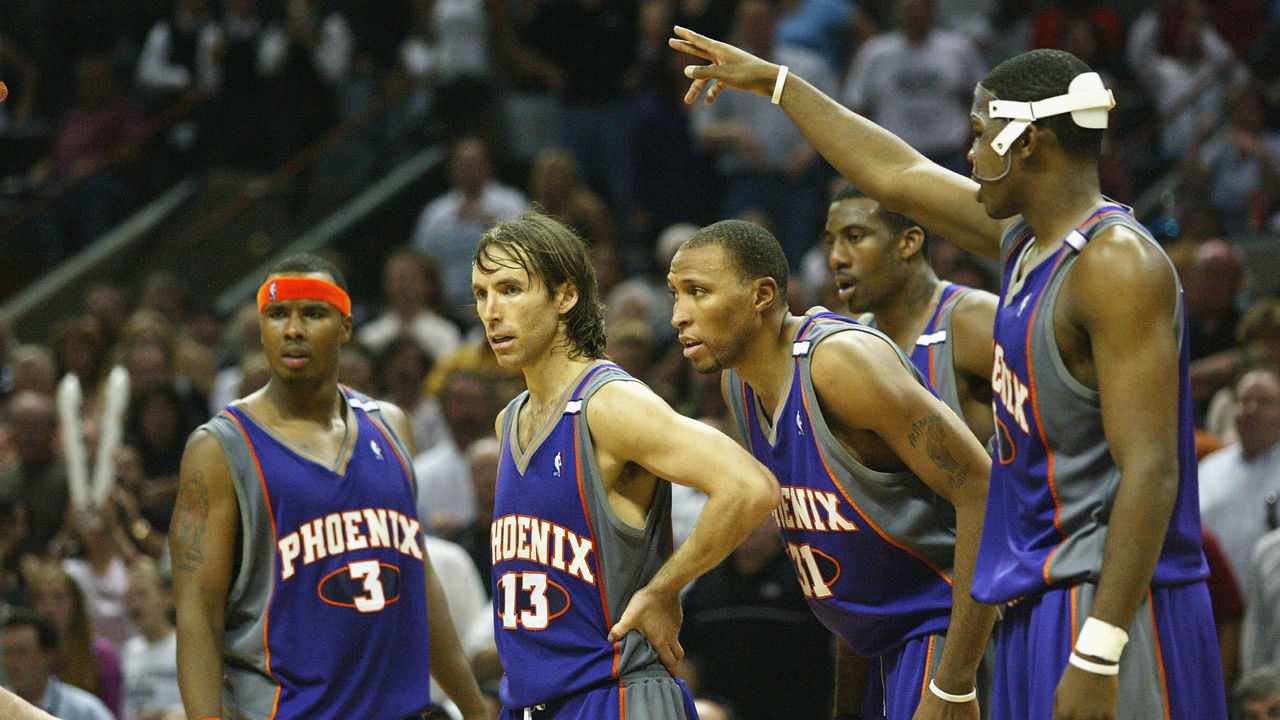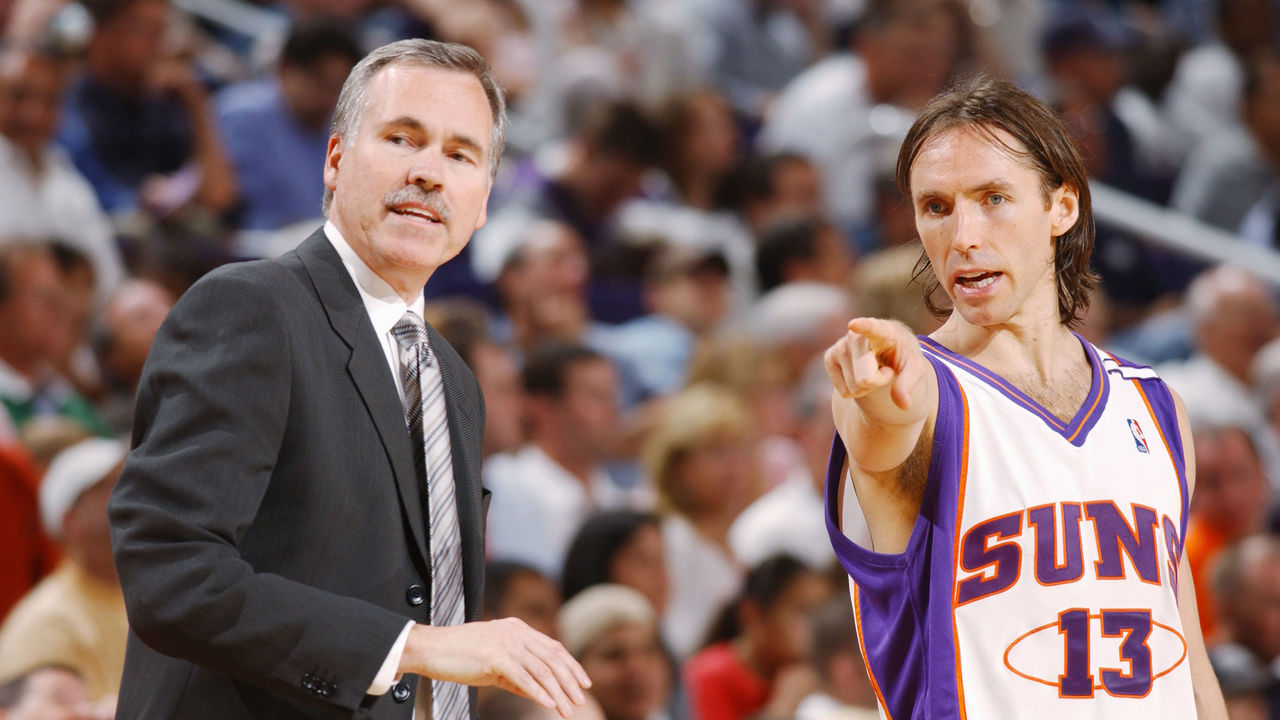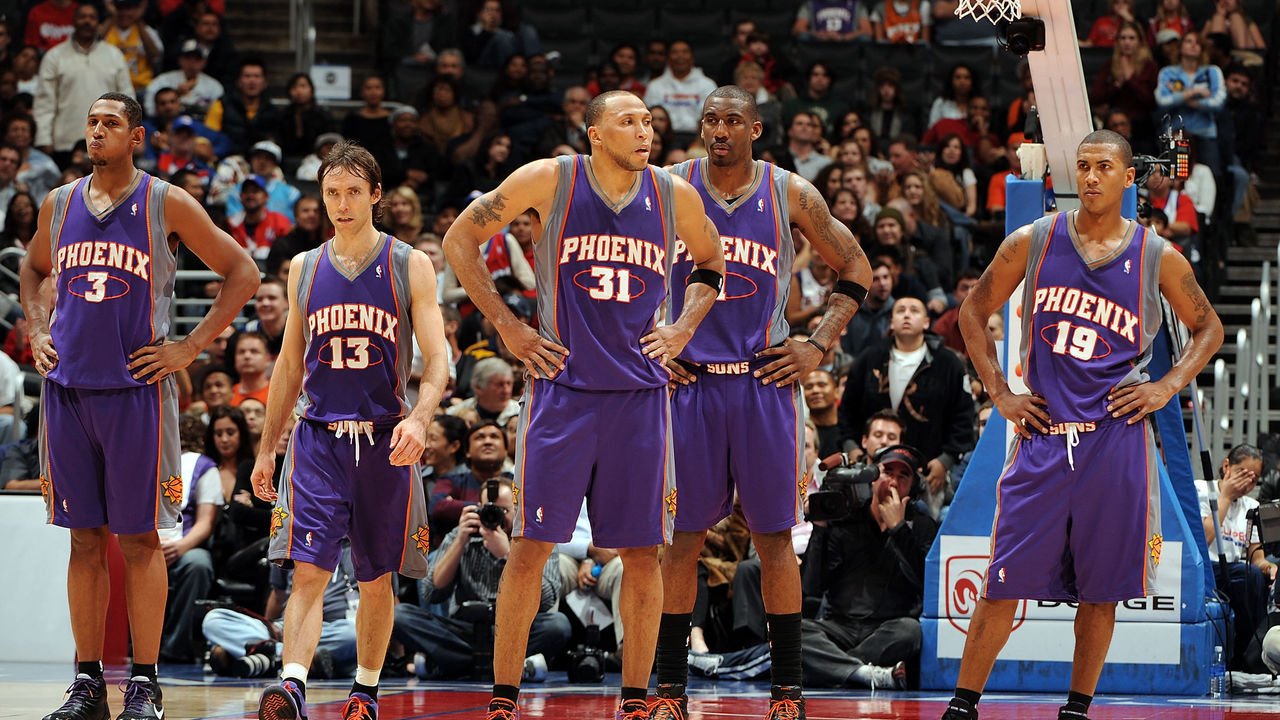Almost Famous: 7 Seconds or Less Suns came up short, but changed the NBA
Sports history is littered with great teams that dominated their regular seasons only to fall short of ultimate glory. Our writers are paying tribute to those teams who were Almost Famous. After tackling NCAA football, NFL, MLB, NBA and the NHL in the 1970s and in the 1990s, here is our second NBA entry.
The era of Phoenix Suns basketball that came to be known as "Seven Seconds or Less" unofficially began 21 games into the 2003-04 season, when the team fired head coach Frank Johnson and promoted assistant Mike D'Antoni as his replacement.
The Suns were still raw and disjointed - they went just 21-40 to close the season under D'Antoni - but the final piece of the puzzle snapped into place in the offseason. That's when the franchise signed 30-year-old point guard Steve Nash after his incumbent team, the Dallas Mavericks, opted not to match a five-year, $65-million offer. In Nash, an ace shooter and playmaking magician who'd thrived in Dallas' up-tempo system, D'Antoni saw the perfect instrument through which he could execute his bold basketball vision.
2004-05
The Suns already had a promising foundation in place with budding young stars Amar'e Stoudemire, Shawn Marion, and Joe Johnson. Nash was the mortar that bound all the parts together, allowing the structure to coalesce into something beautiful and unique. With their indefatigable new floor general, the hyperkinetic Stoudemire, the shape-shifting Marion, and conscience-free 3-point bombers in Johnson and Quentin Richardson, the Suns ran circles around their opponents en route to the NBA's best regular-season record (62-20) and posted the best offensive rating (114.5) since the exalted 1995-96 Bulls (115.2).
Nash and Stoudemire formed the deadliest two-man combo in the league. When they weren't feasting off of drag screens in transition, they were picking defenses apart in the half court with spread pick-and-rolls. Richardson took eight 3-pointers per game in a season that saw eight teams average fewer than 12. The Suns were flexible, too, with Johnson toggling between the 1 and the 3 on offense, and Marion capable of sliding across all five positions defensively.

Contrary to the way most teams were playing in that plodding, mechanical, system-oriented era, the Suns became a bastion of improvisational, read-and-react basketball. They made it a goal to seek out looks early in the clock, to keep opposing defenses in a permanently scrambled state, and - true to their nickname - to get a shot off in seven seconds or less.
Those Suns played at the league's fastest pace, hit more threes than any team had ever hit in a season, and produced a 33-win improvement over 2003-04, the third-biggest year-to-year turnaround in NBA history at the time. D'Antoni was named Coach of the Year. Nash won the first of his two consecutive MVPs. General manager Bryan Colangelo was recognized as the league's top executive.
The early stages of the 2005 playoffs validated the Suns' regular-season success. They swept the Grizzlies in the first round and then won a wildly entertaining - and surely gratifying - six-game series against the Mavericks, during which Nash played perhaps the best basketball of his Hall of Fame career, averaging 30.3 points, 6.5 rebounds, and 12 assists on 63.9% true shooting.
But Phoenix ran into San Antonio in the Western Conference finals, and the runaway train came to a screeching halt. It was a classic clash of styles: the league's best offense against its best defense, run-and-gun versus slow and steady, an unstoppable force meeting an immovable object. The precise, methodical Spurs managed to control the pace and win in five games, even though Stoudemire was the leading scorer in every contest and averaged 37 points in the series. At the end of the day, the Suns just couldn't get enough stops. Manu Ginobili did a particularly nefarious number on them.
As always happens when a great team fails to win the whole shebang, that loss spawned a backlash. Suddenly, there were takes and think pieces galore about how the Suns' style - entertaining though it was - did not a championship formula make. They were too small, too soft, too thin. They couldn't rebound. They relied too heavily on jump shots. Defense won championships, and the Suns were too busy trying to pile up points to worry about how many they were surrendering at the other end.
2005-06

The Suns weren't deterred by those doubts, or by the tumultuous offseason that followed when an impasse in extension talks - the first of many Robert Sarver cheap-outs - led to them trading Johnson to Atlanta. Meanwhile, Stoudemire started to experience knee soreness that ultimately required surgery and sidelined him for all but three games. Richardson was dealt for frontcourt help. But the Suns kept chugging.
In the Johnson deal, they acquired a polymorphous, sweet-passing, 6-foot-8 curiosity named Boris Diaw. D'Antoni unleashed him as a point forward/center/whatever, and he flourished, earning Most Improved Player honors. Free-agent signing Raja Bell, an undrafted wing who'd briefly played with Nash in Dallas, provided a welcome jolt of point-of-attack defense while shooting 44% from deep. Leandro Barbosa and his blinding speed were turned loose on the league. Marion put together a career year. Nash was arguably even better than he'd been the season prior and was rewarded with another MVP.
Though the personnel looked different and the offense wasn't quite as potent, these Suns were still recognizably the Suns, bombing away from deep and turning games into track meets as their puppeteer at the point pulled all the right strings. They won 54 games and then gutted out a pair of seven-game series against the L.A. teams - including a comeback from 3-1 down in the first round against Kobe Bryant's Lakers - to get back to the conference finals.
But the Mavericks, who'd just knocked out the Spurs in an epic seven-gamer, were waiting for them. This time, Dirk Nowitzki was on a mission, and Dallas got the last laugh, prevailing in six.
2006-07
The following season saw the Suns at the peak of their powers, with their best chance to win it all.

Stoudemire returned from his yearlong furlough and submitted an All-NBA campaign while appearing in all 82 games. (The Suns' medical staff earned its own share of plaudits during this run.) Bell made the All-Defensive first team. Nash, once again, somehow managed to get better and finished second to Nowitzki in MVP voting. The Suns won 61 games and scored 3.2 more points per 100 possessions than any other team.
Things looked even more promising after the "We Believe" Warriors bounced the 67-win Mavericks in the first round. If Phoenix could slay its boogeyman from San Antonio in the conference semis, the runway would be totally clear. But, in the final moments of Game 4, with the Suns on the verge of tying the series at two games apiece, Robert Horry delivered a fateful hip check that sent Nash crashing into the scorers' table.
Nash was fine, but the fallout led to one of the most consequential decisions of commissioner David Stern's tenure and the single biggest what-if of the Seven Seconds or Less era. Immediately after the hit from Horry, Stoudemire and Diaw had broken a cardinal rule by leaving the Suns' bench to check on Nash. Some thought the context of the situation would invoke leniency, but Stern decided to enforce the rule to the letter of the law. Both players were suspended for Game 5 in Phoenix.
Though the Suns fought valiantly in that contest and led for most of it, they couldn't hold on. The Spurs held Phoenix to just 85 points and took a 3-2 series lead back to San Antonio, where they shut the door.
The opportunity cost is what makes the 2007 loss burn more than all the others. It really should've been the Suns' year. The Mavs were out of the way, and the East was in shambles. The Spurs went on to dust the Jazz in five games and then sweep a mediocre Cavaliers team in The Finals. There's little doubt Phoenix would've done the same if given the chance.
2007-08
When the team stagnated the following season, its new front office led by Steve Kerr got an itchy trigger finger and dealt Marion for an over-the-hill Shaquille O'Neal. The trade seemed to spell the end of the Seven Seconds or Less era as we knew it, given how dramatically it changed the team's identity and style of play.
The Shaq gambit more or less flopped, but the 2007-08 squad was still really, really good. And while the Suns lost to the Spurs again, this time in five games in the first round, things might well have gone differently if they'd managed to hold onto a 16-point lead and steal Game 1 in San Antonio. Instead, Michael Finley hit a game-tying three at the end of regulation, Tim Duncan hit a game-tying three (!) with three seconds left in the first overtime, Ginobili hit a game-winning layup with 1.8 left in the second OT, and the Suns never recovered from the gut punch.
By the way, that shot was one of just five 3-pointers Duncan hit in 251 career playoff games.
2009-10
After they missed the playoffs in 2008-09, it seemed like the Suns' run was well and truly done. But the following year featured a revival from a new iteration of the team.
Only Nash, Stoudemire, and Barbosa remained from the 2006-07 squad. The roster was now rounded out by the likes of Jason Richardson, Channing Frye, a young Goran Dragic, and a twilight-era Grant Hill. Nash, in his age-36 season, was still an All-NBAer. Shaq was gone, and run-and-gun was back. D'Antoni was gone, too, with the team now stewarded by Alvin Gentry. In what proved to be a last hurrah of sorts for the Nash-led Suns, they finished the season on a 28-7 tear and finally exorcised their demons by sweeping the Spurs in a cathartic second-round series.
So, to the West finals yet again, this time against the defending champion Lakers. In Game 5 at Staples Center, with the series tied 2-2 and a chance to send themselves home for a closeout game, the Suns mounted a furious second-half comeback to knot things up in the dying seconds. On the final possession of regulation, Bryant took an inbound pass and fired up a contested turnaround jumper that came down about 2 feet short of the rim.
Alas, that uncharacteristically wayward trajectory is what allowed the artist formerly known as Ron Artest to swoop in and flip the ball back up just before the buzzer.
The Lakers closed the series out in Game 6, and that was it. Phoenix hasn't been back to the playoffs since.
Legacy
These Suns never won it all, but that doesn't mean they couldn't have won it all.
True, their disappointments owed in part to their blind spots: Defense was always their big bugaboo, and though it was never as bad as the non-pace-adjusted numbers made it seem, it also never rose above league average. Nash and Stoudemire were clearly minus defenders, and as long as they formed the backbone of the team, the Suns' best option was to fight fire with fire.
But the disappointments also owed to a confluence of mitigating circumstances and bad breaks. From the lost Stoudemire season to the Horry hip check, the Duncan three, and the Artest put-back, there were countless inflection points at which a more fortuitous twist of fate could've led Phoenix down the road to a title. For his part, D'Antoni recently told Nash that his only regret about those years is that he didn't push the envelope far enough - that he let the status quo and the opinions of others prevent him from realizing his vision to its fullest extent.
As it was, even though the Suns came up short of the ultimate goal, the rest of the league took notice of what they were doing and decided to get on board. The Warriors built a dynasty on many of the offensive principles those Phoenix teams brought to the mainstream. The Spurs squad that memorably won the title in 2014 looked nothing like the version that once stood in such stark contrast to the Seven Seconds or Less Suns. Those Spurs, in fact, had plenty of Suns DNA (including Boris Diaw) in their system.
Pace-and-space and spread pick-and-roll systems became the bedrock of modern NBA offense. The game has sped up to the point that the 2004-05 Suns would have been the slowest team in the league in 2019-20. To watch the NBA today is to watch the ongoing ripple effects of that seismic moment in league history. If those Suns aren't the best team to never win a championship, they're probably the most influential, and they're certainly the most iconic.
That may not soothe the sting of all the missed opportunities that left them banner-less, but it's a hell of a legacy.
Joe Wolfond writes about basketball and tennis for theScore.